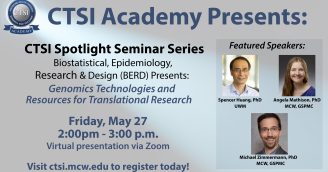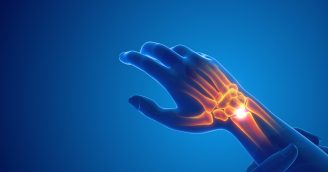
13 Jun Spotlight on MSOE’s Center for BioMolecular Modeling

David Klein (pictured above) is a researcher at the NIH NICHHD. He is holding a physical model of AANAT, an enzyme involved in melatonin synthesis.
Imagine being able to see a molecule with the naked eye. Thanks to the MSOE Center for BioMolecular Modeling (CBM) researchers are now able to visualize the molecules and proteins they study modeled in plastic. The CBM makes it easier for researchers to understand the structural complexities of molecules by making the invisible molecular world “visible”.
The Center develops physical models of proteins and other macromolecules. They can even produce accurate representations of macromolecular structures using cutting- edge 3D printing technology. This unique Center is definitely an asset to the CTSI research community. The TTR interviewed Tim Herman, Ph.D., Director of the Center for BioMolecular Modeling, to get a better understanding of what this Center does and how it can be utilized by CTSI Investigators.
What is the mission of the CBM?
The CBM is an instructional materials development laboratory. Our staff works closely with educators at all levels to create innovative materials with which students can be introduced to the molecular biosciences. In addition to hosting professional development workshops for high school teachers, we also run student-enrichment programs in which either high school students (SMART Teams — Students Modeling A Research Topic) or undergraduates (CREST — Connecting Researchers, Students and Teachers) work closely with a biomolecular research lab to design and build physical models of proteins that are being investigated in the lab.
What types of technologies and resources are available to CTSI researchers through your Center?
The core, enabling technology of our Center is 3D printing. This technology generates accurate physical models of proteins, based on the atomic coordinates of solved structures. Although we have access to five different rapid prototyping technologies, we primarily use either Selective Laser Sintering — to produce durable nylon models — or the color Z Corporation technology — to produce plaster models with complex coloring schemes. Our Center has also developed the technology to incorporate magnets into the protein models, allowing for the assembly of multi-subunit protein complexes, or the docking of substrates/inhibitors into enzyme active sites.
How can your Center’s services be incorporated into translational research?
Physical models of proteins are powerful tools. They can be used as thinking tools by members of research teams, or as communication tools with students and visiting colleagues. Finally, we are just now beginning to explore how researchers can use these models to communicate their science to the surrounding community, as they contribute to the community engagement efforts of the CTSI.
Can you describe the instructional tools that your Center developed to help explain the science behind the One-In-A-Billion story that originated in the Human and Molecular Genetics Center?
After hearing this story from Howard Jacob, we created a 15 ft. long paper model of the XIAP gene — showing the single point mutation that led to the defect in this protein. As luck would have it, this mutation mapped to a domain of the XIAP protein (BIR2) whose structure was known. This allowed us to create a physical model of the protein domain containing this mutation. Remarkably, the mutation eliminates a cysteine residue that normally binds to a zinc atom and contributes to the stability of this zinc finger domain — suggesting a plausible explanation for the compromised function of this protein.
How can CTSI investigators access your Center’s services?
Our Center stands ready to work with any CTSI investigator to create a physical model of a protein that could be used to communicate their science to others. Alternatively, CTSI labs can volunteer to work with one of our student-based model design teams. Participating labs receive a copy of the model that is designed in these projects. As a bonus, the lab can have a significant impact on the future careers of young students….while being reminded of their own enthusiasm for science at that age.











